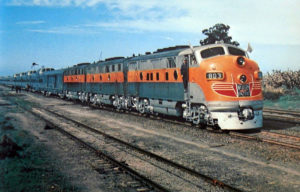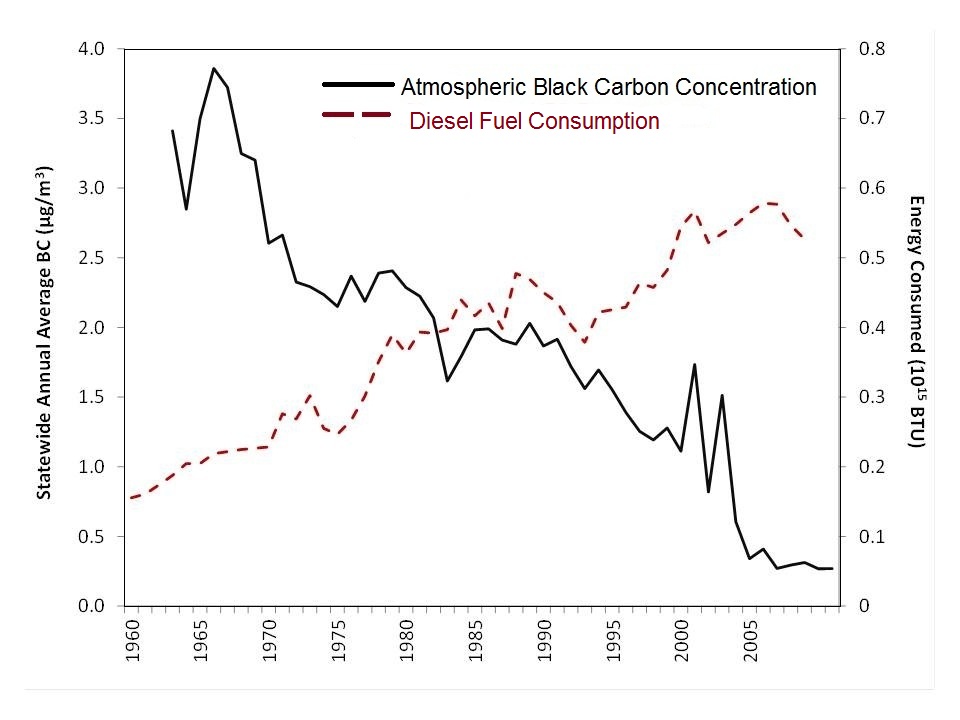On the “Greenhouse Gases Equivalencies Calculator – Calculations and References” page provided by the U.S. Environmental Protection Agency (EPA) one will find a wealth of information related to greenhouse gases like carbon dioxide and their equivalencies.
Two areas of particular note as they relate to carbon-dioxide-emissions-releases from U.S.-based cars and diesel trucks examined are: “Gallons of gasoline consumed” and “Gallons of diesel consumed.”
For every gallon of gasoline consumed, resulting is 8,887 grams of carbon dioxide emissions released into the atmosphere. Similarly, for each gallon of diesel consumed, resulting is 10,180 grams of carbon dioxide emissions released into the air.
So, using the mathematical equivalency of 1 pound equaling 453.6 grams, in performing the conversion of 8,887 grams and 10,180 grams into pounds, this yields 19.59 pounds and 22.44 pounds, respectively.
Therefore, per gallon of gasoline consumed, released into the atmosphere is 19.59 pounds of CO2 gas and per gallon of diesel consumed, into the atmosphere is 22.44 pounds of CO2 gas released.
So, just how much carbon dioxide from cars is emitted into the air in the U.S. annually?
Well, according to other accessible available data on the same EPA page, for 2017, 11,484 miles is the number of passenger vehicle miles traveled in the U.S. on average. And, with the “weighted average combined fuel economy of cars and light trucks” being “22.3 miles per gallon” (refer to: “Passenger vehicles per year” subheading), what this means is that the average amount of gasoline consumed by the passenger vehicles in the United States in 2017, approached 514.978 gallons.
And, what this translates to in terms of annually released average CO2 per-passenger-vehicle emissions in the United States in 2017, is 10,089.53 pounds (5.0447 tons) emitted into the air from gasoline-burning internal-combustion-engine vehicles.
Now, imagine if there was a way to suppress those emissions before leaving vehicle exhaust pipes.
The low-down on surface-transportation-arena exhaust carbon
One of the more common techniques utilized to help rid internal combustion engines, particularly those in automobiles of their buildup of carbon within exhaust manifolds, was to drive the vehicles harder as would be typical of driving on the highway after long periods of city driving. Another was to use fuel additives or so-called “cleaners” poured or sprayed into, for instance, the barrels of engine carburetors directly. Such methods are only marginally effective.

With regard to diesel locomotives, for railroad companies the story was much the same. Carbon build-up within diesel locomotive engine exhaust manifolds was problematic and removal of these deposits was considered advantageous with regard to better operating performance as well as a means to provide for reduced emissions.
On one railroad at least, the Western Pacific Railroad, which, before being merged into the Union Pacific Railroad in 1982, conducted its main operations between San Francisco-Oakland, California and Salt Lake City, Utah, with conducted subordinate operations in numerous locations in the San Francisco Bay Area; the San Joaquin Valley, Sacramento, Chico and Lake Almanor regions, in north-central and northern California, respectively; and Reno in Nevada; to name a few, it was actively engaged in programs in its more recent past to reduce said exhaust-manifold-based carbon-emissions buildup. There were various remedies applied details of which are described in the book D-Day on the Western Pacific, and several, it would appear, proved effective.1
Having implications for the roads-based realm, logic would have it that application along these lines can similarly be found regarding goods movement and motorized transit along with motor vehicle use.
As you can well guess the biggest problem with blowing carbon out of the exhaust manifold using the highway-driving example, is that carbon discharged in this way is being released into the air which provides an opportunity for the small particles emitted to enter into people’s lungs if breathed in, not to mention the combining of carbon and oxygen molecules which can and readily does lead to the formation of excess carbon dioxide in the atmosphere.
Technology to save the day
The automotive industry has come an incredibly long way since its first fledgling days. Today’s cars are light-years more advanced compared to predecessor models of a century ago: The same for trucks and school and transit buses.

Adding to this the Diesel Technology Forum in the same release wrote: “Diesel has long been the technology of choice for the commercial vehicle sector, thanks to its continuous improvement and unique combination of energy efficiency, power and performance, reliability and durability, and most recently, achievement of near-zero emissions.”
Oh, and one other very important point made in the release in question by the Diesel Technology Forum: “Today, the more than 4.9 million new-generation diesel trucks on the road have removed more than 26 million tonnes of NOx [oxides of nitrogen] and 59 million tonnes of carbon dioxide (CO2) compared to previous generations.”
As the numbers of buses, cars and trucks on roadways and trains on railways become greater and greater and more and more miles continue to be logged as a result, efforts that aim to reduce carbon and other harmful pollutant emissions will do much and go far to ensure that internal-combustion-engine operation becomes cleaner and cleaner which will become increasingly more welcome and apropos as time forges ahead.
Notes
- Virgil Staff, D-Day on the Western Pacific: A Railroad’s Decision to Dieselize, “Chap. 22: The Krause-Maffei and Other Anachronisms,” 1982, pp. 158-’61
Images: Publisher: Lyman Cox-photograph: Western Pacific Railroad (upper); California Environmental Protection Agency Air Resources Board (lower)

Newsflash! CO2 is not a “greenhouse gas” nor is methane. There is no significant “global warming” and the entire climate change theory is a complete fraud, starting with the bogus “hockey stick” publication go the fraudster Michael Mann.
https://www.youtube.com/watch?v=K_8xd0LCeRQ
Therefore there is no need to “suppress” CO2 production as it is an essential gas needed for life that increases crop yields while greening the earth.
CO2 is MOST CERTAINLY NOT A “POLLUTANT!”
How much does the equipment weigh? An extra ton doesn’t mean anything to a 50 car freight train.
It seems to me that your metric should be carbon vs miles traveled, rather than carbon vs gallons. When I bought my first diesel, in a car very similar to the gasoline powered version that it replaced, my miles per gallon about doubled — from ≈22 mpg for the ‘gasser’ to ≈45 mpg for the diesel for general driving; and from ≈26 mpg to ≈50 mpg on trips. — Thus the CO2 exhaust figures for the diesel are appreciably less than those for the ‘gasser’ on a per mile basis.
Point taken. I know in Europe and I think in England in particular, in more recent times the public in general, and motorists specifically, were sold on the idea that diesel-powered motor vehicles emitted less in the way of carbon dioxide compared to their gasoline-powered counterparts.
It seems a good many Europeans bought into that notion. In Europe it became a commonly-held belief that in driving diesel-powered motor vehicles, by doing so this would be better for – and easier on – air and with regard to their being less impacting with respect to global warming. This as I understand things.
It was only later that it was discovered that these diesel-powered vehicles were making air quality worse where these vehicles were driven.
Meanwhile, there are people who swear by what has become known as “clean diesel.”
That all said, the reason for my writing this article was to bring to bear that private industry, at least one railroad in this case, undertook efforts to reduce or eliminate carbon buildup in the exhaust manifolds of its diesel-locomotive fleet before such exited said locomotive exhaust stacks and then entered the air around them. It appears the Western Pacific Railroad achieved success in this regard. From this it seems reasonable that solutions similar to this could be directly applied to the road-based motoring sector. Why I chose the EPA data cited is because this is where my research led me in this particular instance.